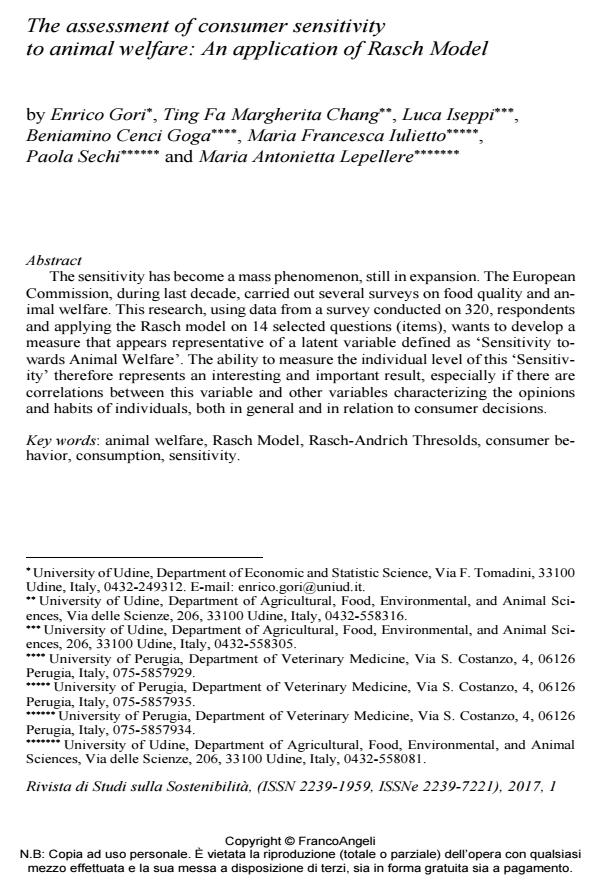The assessment of consumer sensitivity to animal welfare: An application of Rasch Model
Journal title RIVISTA DI STUDI SULLA SOSTENIBILITA'
Author/s Enrico Gori, Ting Fa Margherita Chang, Luca Iseppi, Beniamino Cenci Goga, Maria Francesca Iulietto, Paola Sechi, Maria Antonietta Lepellere
Publishing Year 2017 Issue 2017/1
Language English Pages 21 P. 107-127 File size 275 KB
DOI 10.3280/RISS2017-001008
DOI is like a bar code for intellectual property: to have more infomation
click here
Below, you can see the article first page
If you want to buy this article in PDF format, you can do it, following the instructions to buy download credits

FrancoAngeli is member of Publishers International Linking Association, Inc (PILA), a not-for-profit association which run the CrossRef service enabling links to and from online scholarly content.
The sensitivity has become a mass phenomenon, still in expansion. The Euro-pean Commission, during last decade, carried out several surveys on food quality and animal welfare. This research, using data from a survey conducted on 320, respondents and applying the Rasch model on 14 selected questions (items), wants to develop a measure that appears representative of a latent variable defined as ‘Sensitivity towards Animal Welfare’. The ability to measure the individual level of this ‘Sensitivity’ therefore represents an interesting and important result, especially if there are correlations between this variable and other variables characterizing the opinions and habits of individuals, both in general and in relation to consumer decisions.
Keywords: Animal welfare, Rasch Model, Rasch-Andrich Thresolds, consumer be-havior, consumption, sensitivity
- THE HIDDEN TURNING POINTS OF THE MEDITERRANEAN DIET: A TOOL FOR HEALTH AND AGRO-FOOD POLICIES. RATING OUT OF FIFTY YEARS, AND 22 COUNTRIES Maria Antonietta Lepellere, Ting Fa Margherita Chang, Maurizio Droli, Luca Iseppi, in New Medit /2019 pp.71
DOI: 10.30682/nm1902e - A formal model for assessing the economic impact of animal welfare
improvements at bovine and porcine slaughter J Jerlström, C Berg, AH Karlsson, A Wallenbeck, H Hansson, in Animal Welfare /2022 pp.361
DOI: 10.7120/09627286.31.4.004
Enrico Gori, Ting Fa Margherita Chang, Luca Iseppi, Beniamino Cenci Goga, Maria Francesca Iulietto, Paola Sechi, Maria Antonietta Lepellere, The assessment of consumer sensitivity to animal welfare: An application of Rasch Model in "RIVISTA DI STUDI SULLA SOSTENIBILITA'" 1/2017, pp 107-127, DOI: 10.3280/RISS2017-001008